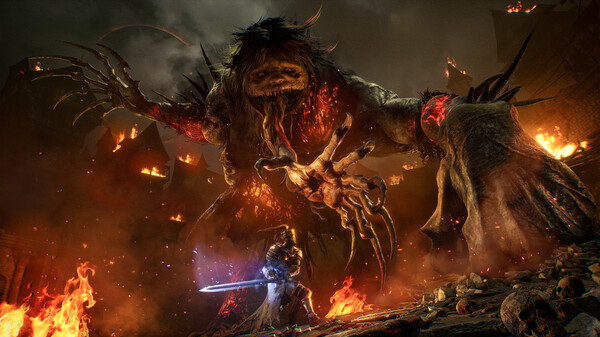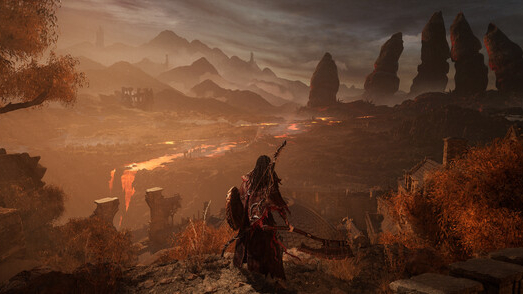Lords of the Fallen preview - an Elden Ring for the rest of us
Hero of two worlds

As the archangel swings her fearsome blade, I find myself getting into a rhythm. Each blow can be dodged; it's just a question of timing. I weave around her attacks, whittling down her health bar before disengaging. I’m too late; my character slumps to the ground. My fight against the first set-piece boss of Lords of the Fallen is over.
Or so you might think.
I awaken, surrounded by skeletal constructs and bathed in an eerie purple light. The archangel is still here. The fight, it seems, is still on.
Unfortunately for my opponent, I’ve learned my lesson. This time, I don’t get greedy. This time, she falls, no number of celestial swords of angelic powers a match for well-timed dodges.
On the surface, Lords of the Fallen looks indistinguishable from Elden Ring
It’s only after the satisfaction fades that I realize something vital. Throughout the slog through hills and ruins to arrive at the encounter, the game has been preparing me, teaching me how to parry, dodge, and block. In only an hour or so, Lords of the Fallen had made me better at video games.
On the surface, Lords of the Fallen looks indistinguishable from Elden Ring. You adventure through bleak, yet hauntingly beautiful environments in search of ending the tyranny of an ancient horror. It’s a third-person action RPG where you battle from save point to save point, doing your best not to perish and lose your precious resources.
However, Lords of the Fallen changes the script, by taking the time to teach its players and offering a fast, responsive combat system where you can put these lessons into practice. In contrast to the more ponderous combat in Elden Ring, Lords of the Fallen gives us something faster and more fluid, reminiscent of the splendid lightsaber contests in Star Wars Jedi: Survivor.
Sign up for breaking news, reviews, opinion, top tech deals, and more.
Walking between worlds

On top of these welcome tweaks to the soulsborne formula, Lords of the Fallen uses a novel environmental mechanic whereby the two worlds of Axiom, the world of the living, and Umbral, the land of the dead, are superimposed on one another, traversable via a magic lantern.
Can’t cross a chasm? You can use your lantern to peer into Umbral to see if a transposition might allow you to cross the gap. However, this doesn’t come without risk. Enter Umbral, and you’ll quickly find yourself hunted by increasingly dangerous hordes of shambling horrors. On top of that, the trip from Axiom to Umbral is one way without the help of special items or rest points, so the decision to cross the threshold is anything but trivial.
Perhaps the most wide-reaching effect of this mechanic comes in the form of the second chance it gives the player during battle. Perish in Axiom, and you’ll revive in Umbral, pushing back your enemies with a burst of energy before continuing the fight exactly where you left off.
This allows you a final chance to apply the game’s lessons in combat, offering you one last opportunity to learn from your mistakes. Rather than a coddling safety net, this feels like a love letter to soulsborne fundamentals. Learn and improve, and you’ll survive, but repeat your errors, and you’ll perish.
Fighting with purpose

Everything about Lords of the Fallen seems more accessible than most of its soulsborne counterparts, though rarely at the expense of the “tough but fair” grind at the heart of the genre. This is true not only of the combat but also of the world itself.
While Lords of the Fallen is steeped in the usual dark fantasy intrigue you’d expect from a typical soulsborne title; there is just enough direct exposition to give the intrigue context. The plot is simple and comprehensible: you must stop the demon god Adyr by traveling the world and confronting the fallen guardians who tried (and failed) to keep him imprisoned.
Lords of the Fallen’s polished combat and distinctive flavor set it apart from many of its soulsborne contemporaries
It’s hardly original, but, thanks to the clear exposition, I found myself able to piece together more about Lords of the Fallen’s setting in three hours than I managed in my first 10 hours with Dark Souls 3 back in the day. Knowing about the world and your place in it helps to give your struggles some much-welcome context, putting the “role” back in action in role-playing game.
Lords of the Fallen’s polished combat and distinctive flavor set it apart from many of its soulsborne contemporaries. While many of its ideas are not original, per se, they are all refined and repackaged, presented in a more accessible format that still preserves the satisfying difficulty at the heart of the soulsborne experience.
While it’s too early to say if Lords of the Fallen meaningfully builds on this in later stages, the promise of a user-friendly soulsborne title will certainly pique interest.
Lords of the Fallen is set to release on October 13 for PS5, Xbox Series X|S, and PC.

An editor and freelance journalist, Cat Bussell has been writing about video games for more than four years and, frankly, she’s developed a taste for it. As seen on TechRadar, Technopedia, The Gamer, Wargamer, and SUPERJUMP, Cat’s reviews, features, and guides are lovingly curated for your reading pleasure.
A Cambridge graduate, recovering bartender, and Cloud Strife enjoyer, Cat’s foremost mission is to bring you the best coverage she can, whether that’s through helpful guides, even-handed reviews, or thought-provoking features. She’s interviewed indie darlings, triple-A greats, and legendary voice actors, all to help you get closer to the action. When she’s not writing, Cat can be found sticking her neck into a fresh RPG or running yet another Dungeons & Dragons game.